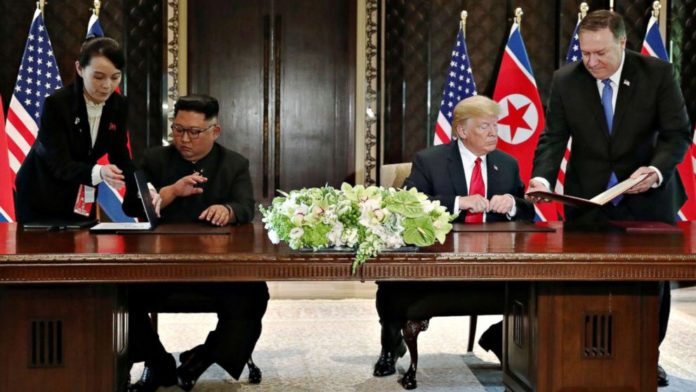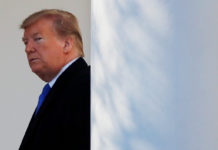Flying back from Singapore on Air Force One, President Donald Trump portrayed his summit with Kim Jong Un as a home run.
“Heading back home from Singapore after a truly amazing visit, ” he tweeted. “Great progress was made on the denuclearization of North Korea. Hostages are back home, will be getting the remains of our great heroes back to their families, no missiles shot, no research happening, sites closing…”
Heading back home from Singapore after a truly amazing visit. Great progress was made on the denuclearization of North Korea. Hostages are back home, will be getting the remains of our great heroes back to their families, no missiles shot, no research happening, sites closing…
— Donald J. Trump (@realDonaldTrump) June 12, 2018
Earlier Tuesday, after a day of meetings and a long working lunch with advisors, Trump and Kim signed their names in black pen on a one-page agreement. Cameras clicked as Trump proudly presented the document to the world and declared the summit a success.
But once journalists zoomed in on the words of the document, it became clear that beyond orchestrating elaborate international stagecraft and laying the groundwork for peace on the Korean peninsula, the United States did not accomplish many of the goals outlined by officials ahead of the summit. Instead, North Korea’s leader established himself as a global player on the world stage and reaffirmed previous commitments and the United States walked away with many items on its diplomatic checklist unaccomplished.
Secretary of State Mike Pompeo, who was responsible for laying much of the groundwork for Tuesday’s summit, told reporters on Monday the “only outcome the United States will accept” is the “complete and verifiable denuclearization of the Korean Peninsula.” But notably missing from the document signed by Trump and Kim was the word “verifiable.”
“The ‘v’ matters,” Pompeo had told reporters the day before the summit, referring to “verifiable.”
But the agreement reached by both parties was short on specifics or concrete ways the North Koreans plan to work towards denuclearization.
“I read the statement and it’s difficult for me to see if something was actually agreed to or not,” Sen. Bob Corker, chairman of the Senate Foreign Relations Committee, said Tuesday.
No outline of how to work toward denuclearization
The No. 1 goal for Tuesday’s summit was to get North Korea to agree to “complete and verifiable denuclearization.” The four agreements outlined in the document signed by Trump and Kim, include establishing new U.S. – North Korea relations, joining efforts for establishing a “lasting and stable peace regime on the Korean Peninsula,” North Korea reaffirming the 2018 Panmunjom Declaration and working toward “complete” denuclearization of the Korea Peninsula, and the North Koreans recovering POW/MIA remains.
Experts were quick to point out that the agreement was short on specifics and only paved the way for more talks between the two countries. The document assigns Pompeo and a “relevant high-level DPRK official” to meet at a later date to “implement the outcomes” of the summit.
In a press conference with reporters after the summit, Trump admitted that he simply did not have enough time to secure the details for “complete, verifiable, irreversible denuclearization.”
“I’m here one day,” Trump said. North Korea has started denuclearization, Trump said. “They blew up their testing site.”
Despite North Korea blowing up one of its nuclear testing sites, the United States failed to secure any kind of timeline for when – or how – North Korea will denuclearize.
No mention of sanctions, U.S. commits to security guarantees for North Korea
Trump said in his post-summit press conference that he wants significant improvement in human rights and the elimination of nuclear weapons in North Korea before the United States lifts sanctions.
“The sanctions will come…










